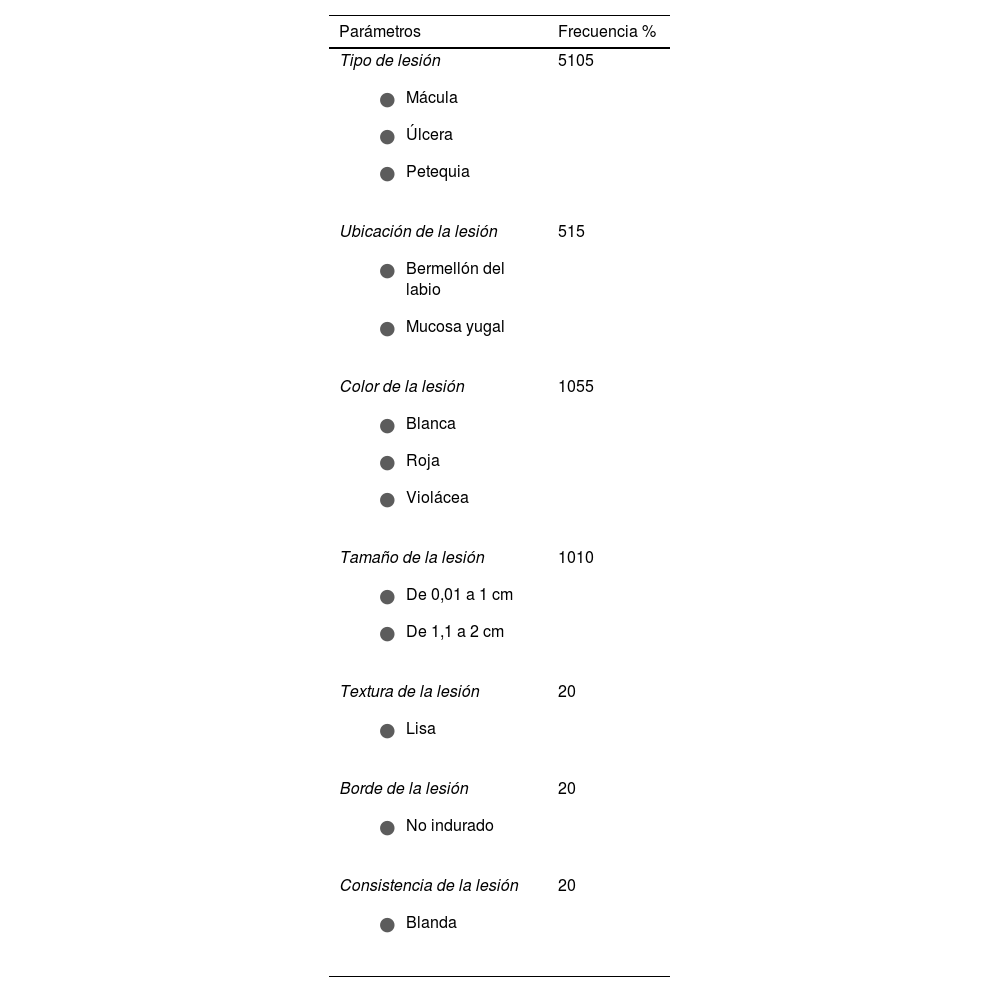la rosácea es una enfermedad inflamatoria crónica que afecta predominantemente a la piel de las mujeres sobre los 30 años. Su importancia radica en que puede conducir a alteraciones en la mucosa ocular, degeneraciones en el aspecto psicosocial de la persona que la padece, entre otras alteraciones. La rosácea modifica los niveles de metaloproteinasas de la matriz en el fluido crevicular gingival, sugiriendo que la rosácea puede causar cambios orales. Hasta la fecha, la presencia de lesiones en la mucosa oral no ha sido investigada.
Objetivodeterminar la frecuencia y tipo de anormalidades en la mucosa oral en individuos con rosácea.
Materiales y métodoslos individuos fueron seleccionados por conveniencia, diagnosticados con rosácea por un dermatólogo. Se incluyeron individuos mayores o iguales a los 18 años. Los individuos con enfermedades sistémicas (lupus, diabetes, psoriasis, artritis reumatoide, etc.) fueron excluidos. Previo al examen de la mucosa, se realizó una ficha clínica recolectando la información entregada por el paciente. El examen clínico intraoral se llevó a cabo observando y palpando las estructuras y posibles lesiones.
Resultadosse incluyeron 20 individuos con diagnóstico de rosácea, un 95% correspondió a mujeres y la edad promedio fue de 32,15 años. La frecuencia de anormalidades en la mucosa oral fue de un 20%, el tipo y ubicación más frecuente fue la úlcera oral y mucosa yugal, respectivamente.
Conclusiónlos resultados de este estudio piloto mostraron que el 20% de los sujetos estudiados presentaron lesiones orales que variaron entre úlcera, petequia y mácula, siendo la más frecuente la úlcera.
Rosacea is a chronic inflammatory disease that mainly affects women’s skin over the age of 30. Rosacea’s importance lies in that it can lead to ocular mucosa alterations, degenerations in the psychosocial aspect of the person who suffers from the disease, among other alterations. Interestingly, rosacea modifies the levels of matrix metalloproteinases in the crevicular fluid, suggesting that rosacea may cause changes at the oral level. Apart from the evidence that exists, up until now, the presence of lesions in the oral mucosa has not been investigated.
ObjectiveIdentify the frequency and type of abnormalities in the oral mucosa in individuals with rosacea.
Materials and methodsThe subjects were selected by convenience previously diagnosed with rosacea by an expert dermatologist. Everyone was 18 or older. Individuals with systemic diseases (lupus, diabetes, psoriasis, rheumatoid arthritis, etc.) were excluded from the study. Before the mucosa exam, a clinical record was made from the information provided by the patient and for the oral cavity mucosa, an intraoral clinical examination was carried out by observing and palpating structures and possible lesions.
Results20 subjects were included with a diagnosis of rosacea, 95% of them were woman and the average age was 32.15. The frequency of abnormalities in the oral mucosa was 20%, the more frequent type and location was oral ulcer and yugal mucosa, respectively.
ConclusionThe results of this study showed that 20% of the subjects studied presented oral lesions that varied between ulcer, petechia and taint, the ulcer being the most frequent.
Artículo
Comprando el artículo el PDF del mismo podrá ser descargado
Precio 19,34 €
Comprar ahora






